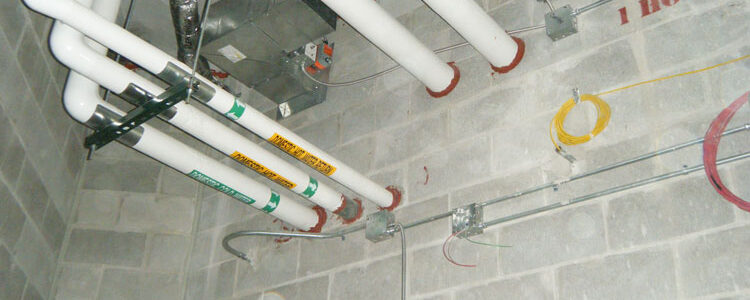Fire Caulking
Fischer Mechanical performs all types of fire caulking for all types of mechanical components. The personnel applying the fire caulk are all trained and certified to apply fire caulk properly and to the required specifications. Fischer Mechanical understands the results of not properly installing fire caulk. Many lives have been saved by all of the fire protection components created..
Firestopping is the use of building materials which prevent the spread of flames, heat or hot gases through penetrations in fire-rated walls, ceilings or floors for items such as pipes, ducts, conduits and cables.
Fire Caulk:
Fire caulking installation is a process that is governed by federal, state, and local building codes. Local building codes override all other agencies. The local building codes are not held responsible for fire caulking not being installed properly. The fire caulking must be installed correctly for the item that is being fire caulked. Many pipes and other components are going through fire rated walls and floors. Pipes are made up of many different materials, and all of the materials have a different melting point. A carbon pipe does not require the same amount of fire caulk as a PVC pipe going through a wall. A PVC pipe will melt at a temperature of around 400 degrees Fahrenheit. Fire caulk is designed to expand and fill that void of the melted pipe during a fire. Most fire caulks begin to start activating at temperatures greater than 200 degrees Fahrenheit. Since more lives are lost by the smoke of fires, fire caulk is also designed to help keep smoke from spreading.
History of Firestopping:
Fires in buildings around the world take many lives every year. In buildings fires can turn small cracks around plumbing, electrical, and HVAC components into a conduit for flames or deadly gases.
Insurance companies started to realize the importance to have firestop products as means to limiting property loss. In the beginning, firestopping products were designed for use in factories to keep expensive machinery and equipment from being destroyed in fires.
After large damage awards in personal safety, fire protection became mandated by building codes. Firestopping not only saved property, but more important, firestopping can save lives.
Standard Method of Fire Tests of Through-Penetration Firestop:
The Underwriters Laboratories (UL) performs test on firestopping products and gives them designated ratings. These ratings help determine which product can be used for a certain application.
- F-Rating – Flame does not pass through for test duration.
- T-Rating – The time which the non-fireside reaches approximately 400 degrees Fahrenheit.
- To receive either rating the firestop must pass hose stream test. (The hose stream test is not to see if the product stays in place from firehoses. The hose test is designed to mimic the pressure created in a room or space during a fire.)
- L-Rating (optional) – Amount of air leakage through the FS system at ambient and 400 degrees Fahrenheit. Determines the system’s ability to restrict the movement of smoke. Measured in CFM/sq. ft. the lower the number, the better.
References:
Hilti Products, Hilti.com; Copyright 2017
How To Avoid Firestopping Liability, Pszanka-Laying, Karen L. 1997
International Firestop Council, Firestop.org, Copyright 2013


